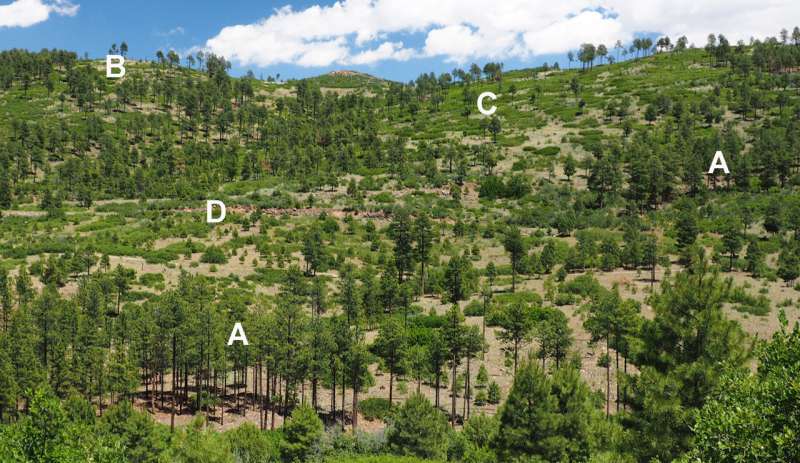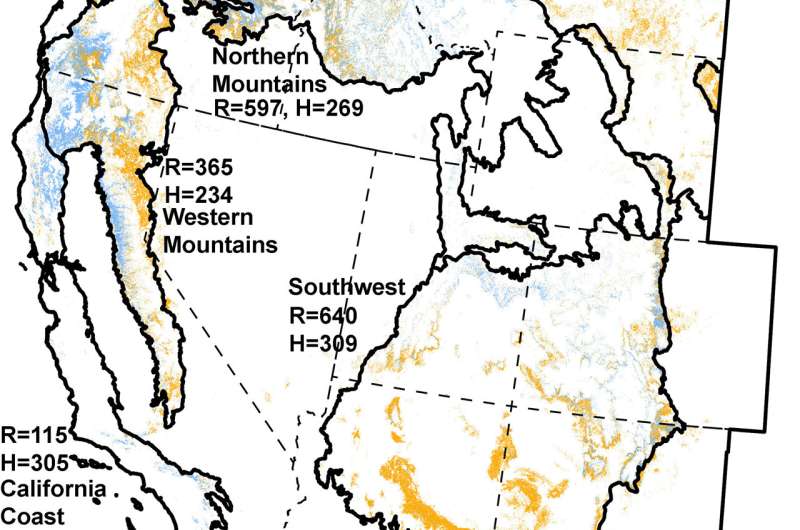May 3, 2024 dialog
This article has been reviewed according to Science X's editorial process and policies. Editors have highlighted the following attributes while ensuring the content's credibility:
fact-checked
trusted source
written by researcher(s)
proofread
Contemporary wildfires not more severe than historically in western US dry forests: Study

Wildfires have increased over the last few decades in dry forests, which cover 25.5 million ha (63 million acres) of the western U.S. But are high-severity fires that kill 70% or more of trees already burning at rates that exceed historical (preindustrial) rates?
I addressed this question in a new study in Sustainability. Dry forests are ponderosa pine (Pinus ponderosa) and dry mixed-conifer forests with ponderosa dominant, but other trees are common. They often occur at the lower limits of forests near woodlands, shrublands, and grasslands.
Earlier, we showed these forests were historically subject to a mixture of low-, moderate- and high-severity fires, as occurred recently in a fire I photographed in a dry forest in northern New Mexico. This mixed-severity historical fire model better fits historical evidence, so the alternative low-severity fire model was rejected.
A 2023 study used US Government Landfire data to show that recently, dry forests have a greater percent high-severity fire than historically assumed. The rejected low-severity fire model was an underlying assumption.
That study by Parks et al. did not explain that the percentage of high-severity fires is ambiguous and does not necessarily mean that the high-severity area burned has increased. Lower-severity fires, easier to put out, could simply have declined more from fire suppression, leaving a larger percentage burning at high severity without more high-severity areas burned. I hypothesized that this explains the higher percentage of high-severity fires found by that study.
If my explanation is correct, this has very different implications for managing dry forests than if the actual area burned has increased relative to historical. If more areas of dry forests are burning at high severity, then reducing high-severity fires may be sensible to restore and sustain forests. However, if my explanation is correct, then the primary ecological need is not to reduce high-severity fires, but instead to restore low- and moderate-severity fires.

I used recent fire-severity data for 2000–2020 from the government's Monitoring Trends in Burn Severity program. I compared these recent data with Landfire's estimates of both percentages and area burned by historical fire by severity.
I did this for 48 physically and biologically distinct settings across ponderosa pine and dry mixed-conifer forests of the 11 western States and within five ecoregions.
The test measure is the fire rotation (FR), which is the expected period to burn across a land area equal to a land area of interest. This is calculated by first summing the area burned by severity over the test period within the land area of interest, then dividing the time period by the fraction of the land area burned.
For example, if the sum of the area burned at high severity over 21 years was 5,000 ha in a 25,000 ha study area, then FR=21 / 0.2, which is 105 years. I also calculated the percentage of recent and historical fires by severity, then tested whether just restoring recent low- and moderate-severity fires to historical levels would also restore the percentage of high-severity fires, my hypothesis.
I found that the percentage of high-severity fires is higher recently than historically, as found by Parks et al. However, recent high-severity FRs, which measure area burned, were found to be longer than historical FRs in dry forests overall across four of the five Ecoregions.
This shows that areas burned at high severity are not higher recently than historically, so contemporary wildfires are not more severe than they were historically. The only exception was the California Coast Ecoregion, long known to be suffering from extensive human-set fires and climate change.
I also found that simply restoring recent low- and moderate-severity fires to their historical FRs would reduce recent percent high-severity fires to 5%, only half of the 10% historically. This is further evidence that the primary ecological restoration need is not to reduce high-severity fires but to restore all fire severities to their historical FRs.
Overall, low-severity fires need to increase 5.8 times, moderate-severity fires 4.4 times, and high-severity fires 1.9 times to equal historical FRs. The higher recent percentage of high-severity fires does not mean that contemporary fires are more severe, but instead that low- and moderate-severity fires were suppressed more than high-severity fires.
These findings show that government land-management agencies (e.g., U.S. Forest Service, Bureau of Land Management) are spending billions each year in a misdirected effort to reduce high-severity fires using expensive fuel-reduction treatments.
Wildfires are shown in my study to not be burning at higher rates than their historical rates in dry forests of the western U.S., so fuel reductions are not restorative. They are simply more fire suppression, which is likely why fires of all severities are burning at rates well below their historical rates. This is documented here using the government's own recent and historical fire data.
Recent high-severity FRs remain quite long, from 365 to 640 years, except in California, allowing more than ample time for fully recovery after fires. Climate change likely means that wildfires will continue to increase, but this recent evidence shows that dry forests are at risk from wildfires.
A legitimate public concern is the possibility of wildfires burning into communities, causing wildland-urban interface fire disasters. However, senior U.S. Forest Service researchers recently published a scientific paper entitled "Wildland-urban fire disasters aren't actually a wildfire problem," explaining the need to refocus on treating areas close to buildings and infrastructure, rather than trying to stop wildfires in forests.
My study, using the government's own data, similarly shows that wildfires of all severities remain deficient in area burned, relative to historical wildfires, in most dry forests, except in California. To solve the problem of wildland-urban interface fire disasters, and prepare for future wildfires, government data show we do not need to reduce high-severity fires in dry forests; we need to redirect government funding to adapting communities and infrastructure to wildfires.
This story is part of Science X Dialog, where researchers can report findings from their published research articles. Visit this page for information about Science X Dialog and how to participate.
More information: William L. Baker, Contemporary Wildfires Not More Severe Than Historically: More Fire of All Severities Needed to Sustain and Adapt Western US Dry Forests as Climate Changes, Sustainability (2024). DOI: 10.3390/su16083270
Dr. William L. Baker is Emeritus Professor, Program in Ecology and Evolution, University of Wyoming, Laramie, WY. He is the author of more than 150 peer-reviewed publications and several books on vegetation ecology, including the effects of natural disturbances.





















